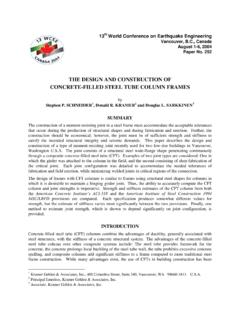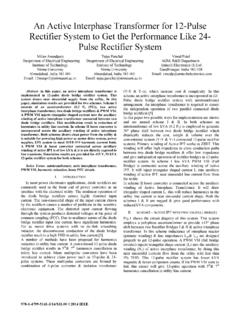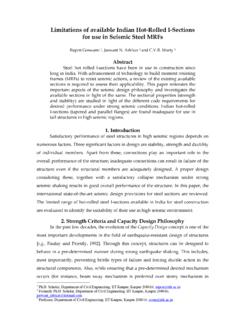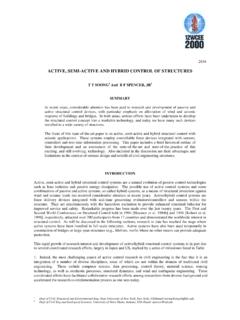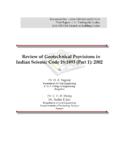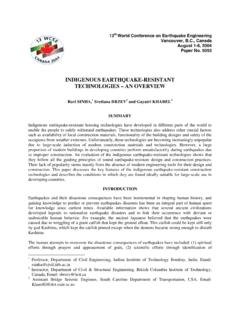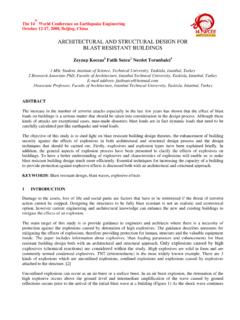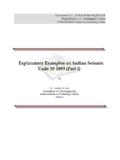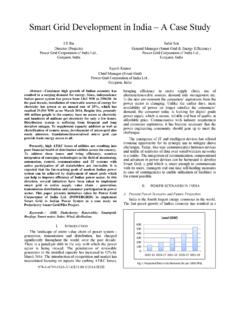Transcription of IS 4905 (1968): Methods for random sampling - IIT Kanpur
1 Disclosure to Promote the Right To Information Whereas the Parliament of India has set out to provide a practical regime of right to information for citizens to secure access to information under the control of public authorities, in order to promote transparency and accountability in the working of every public authority, and whereas the attached publication of the Bureau of Indian Standards is of particular interest to the public, particularly disadvantaged communities and those engaged in the pursuit of education and knowledge, the attached public safety standard is made available to promote the timely dissemination of this information in an accurate manner to the public. 1 + , 1 + 0 1 ' 5 . Mazdoor Kisan Shakti Sangathan Jawaharlal Nehru The Right to Information, The Right to Live Step Out From the Old to the New . IS 4905 (1968): Methods for random sampling [MSD 3: Statistical Methods for Quality and Reliability]. ! $ ' + - . Satyanarayan Gangaram Pitroda Invent a New India Using Knowledge.
2 ! > 0 B .. Bhart hari N ti atakam Knowledge is such a treasure which cannot be stolen . IS : 4905 1968. (Reaffirmed 2001 ). Indian Standard Methods FOR random sampling . ( Eighth Reprint DECEMBER 2002 ). UDC C Copyright 1969. BUI!EAU OF INDIAN STANDARDS. MANAK BHAVAN. 9 BAHADUR SHAH ZAFAR MARG. NEW DELHI 110002. Gr8 May 1969. IS: 4905 1968. Indian Standard Methods FOR random sampling . Methods of sampling Sectional Committee, SMDC 4. Chairman Representing DR A. V. SUKHATME The Tata Iron & Steel Co Ltd, Jamshedpur Members SHRl V. D. AGARWAL Light Metals and Their Alloy Products Sectional Committee, SMDC 10, lSI. SHRI O. P. MATHUR ( Alternate). SHRI J. BHATTACHARJEE Directorate General of Inspection (Ministry of Defence). DR U. N. BHRANY Indian Iron & Steel Co Ltd, Burnpur SHRI A. C. ~1 UKHERJEE (Alternate). CHEMIST & METALLURGIST, SOUTH Railway Board ( Ministry of Railways). EASTERN RAILWAY, KHARAGPUR. CHEMIST & METALLURGIST-I, RDSO, LUCKNOW ( Alternate). SHRI R. N. DATTA Directorate General of Ordnance Factories ( Ministry of Defence), Calcutta SHRI D.
3 K. CHAKRAVARTY (Alternate). ( M uradnagar ). SHRI D. SEN ( Alternate). ( Katni ). SHRI S. B. FIRKE Copper and Copper Alloys Sectional Committee, SMDC II, lSI. SHRI K. C. CHOUDHURI ( Alternate). (Lucknow). SHRI S. S. VAJDYANATHAN ( Alternate). (Bombay). SHRI A. GUHA Cast Iron and Malleable Cast Iron Sectional Committee, SMDC 9, lSI. SHRI S. S. HONAVAR Italab Private Ltd, Bombay SHRt J. P. PATEL ( Alternate). DR Essen & Co, Bangalore; and Ores and Raw Materials Sectional Committee, SMDC 16, lSI. SHRI K. N. GURURAJACHAR ( Alternate). SHRI R. M. KRISHNAN Foundry Sectional Committee, St\'IDC 17) lSI. SHRI D. B. LAHIRI Indian Statistical Institute, Calcutta DR A. MATTHAI ( Alternate). SMRI N. MAJUMDAR Indian Non-ferrous Metals Manufacturers' Associa- tion, Calcutta SHRt M. 1\1. MOUDGILL (Alternat,). DR N. T. MATHEW Statistical Organization ( Ministry of Defence). SHRI S. P. AOARWALA (Alternate). SHRI A. K. MITRA Mitra S. K. Private Ltd, Calcutta SHRI M. N. MITRA ( Alternate).
4 ( Continued on pag 2 ). nUI{EAIJ {)F INDIAN STANDARDS. MANAK BIIAVAN, 9 DAIIADUR SHAll ZAFAR MARG. NEW DELIII 110002. IS : 4905 1968. ( Continuedfrom pag' 1 ). It/embers R,p"s,ntin, SHRt N. C. MITRA Government of India Mint ( Ministry of Finance). DR M. K. BOSE (Altlrnat'). SHRI S. N. MUKER}I National Test House, Calcutta SHRI A. K. BHATTACHARJEE ( Alternate). DR G. MUKHERJEE Ferro Alloys Sectional Committee, SMDC 8, lSI; and Steel Tubes, Pipes and Fittings Sectional Committee, SMDC 22, lSI '. DR D. N. NANDI Refractories Sectional Committee, SMDC 18, lSI. Steel Forgings Sectional Committee, SMDC 21, lSI. SHRI M. R. PATEL Directorate General of supplies & Disposals ( Inspection Wing ) ( Ministry of Works, Housing & Supply). SHRI B. B. BANERJEE ( Alternate). SHRI M. K. RAO Lead, Zinc, Tin, Antimony and Their Alloys Sectional Committee, SMDC 12, lSI. SHRI D. K. RAY wrought Steel Products Sectional Committee, SMDC 5, lSI. SHRI G. V. D. UPADHYAYA Indian Bureau of Mines ( Ministry of Steel, Mines &.}
5 Metals), Nagpur SHRI U. N. SARKAR ( Alternate ). SHRI S. VISWANATHAN Methods of Physical Tests Sectional Committee, SMDC 3, lSI. DR B. N. SINOH, Director Genera], lSI ( klemher). Director ( Stat). Secretary SHRI Y. K. BRAT. Deputy Director ( Stat), lSI. Panel for random Sarnpling, S~fDC 4 : P7. Convener DR D. SINGH Institute of Agricultural Research Statistics ( leAR ), New Ddhi Members DR N. T. l\lATHEw Statistical Organization ( Ministry of Defence). SHRI A. S. Roy Indian Statistical Institute, Calcutta 2. AMENDMENT JULY 1992. TO. IS 4905: 1968 Methods FOR random sampling . (Page 14, Example 14, line 6) - Substitute 'less than or equal to 999' for 'less than 999'. (page 14, Example 14, last sentence) - Substitute the following for the existing sentence: 'This procedure will result in the rejection of very few numbers- those above 489 and less than or equal to 500 and again tbose above 989 and less than or equal to 999 (which give remainders greater than 489 when divided by 500 ), thereby leading to the rejection of only 21 numbers as compared to 510 by the earlier procedure.
6 '. (MSD3 ). Printed at Simco Printing Press. Delhi IS : 4905 1968. Indian Standard Methods FOR random sampling . o. FOR E WORD. This Indian Standard was adopted by the Indian Standards Institution on 20 December 1968, after the draft finalized by the Methods of sampling Sectional Committee had been approved by the Structural and Metals Division Council. sampling is of fundamental importance for estimating the quality of a lot or ascertaining its conformity to the requirements of a specification. The economy, reliability and practicability of the sampling procedures have made them almost indispensable in most of the industrial and trade applica- tions. However, the reliability of the conclusions drawn on the basis of the sample depends on its representativeness and the method of its selection. Since this vital aspect of sampling has not received wide attention, it was felt desirable to lay down the basic procedures for the selection of a random sample under diverse situations.
7 It is hoped that the sampling Methods as laid down in this standard, when implemented, would ensure a truly random and representative sample leading to sound and satisfactory estimation of lot quality. This standard is one of a series of Indian Standards relating to techniques of statistical quality control. Other standards published so far in the series are: IS : 397-1952 Method for statistical quality control during production by the use of con trol chart IS: 1548-1960 Manual on basic principles of lot sampling IS : 2500 ( Part I )-1963 sampling inspection tables: Part I Inspection by attributes and by count of defects IS: 2500 ( Part II )-1965 sampling inspection tables: Part II Inspec- tion by variables for percent defective IS : 5002 .. 1969 Method for determination of the sample size to estimate the average quality of a lot or a process In preparing this standard, considerable assistance has been derived from the following publications: COCHRAN (W G). sampling techniques.
8 John Wiley & Sons, Inc, New York. DEMING ( WE). Some theory of sampling . John Wiley & Sons, Inc, New York. 3. IS : 4905 1968. HANSEN ( M H ), HURWITZ ( W N ) and MADOW (W G). sampling survey Methods and theory. Vol I Methods and applications, Vol II Theory. John Wiley & Sons, Inc, New York. SUKHATME (P V). sampling theory of surveys with applications. Indian Society of Agricultural Statistics, New Delhi. A million random digits with 100 000 normal deviates. 1955. Rand Corporation, Illinois, USA. In reporting the result of a test or analysis, if the final value, observed or calculated, is to be rounded off, it shall be done in accordance with IS : 2-1960*. 1. SCOPE. This standard lays down general procedures for the selection of items from a lot on an objective basis by using random sampling techniques. It also describes the Methods of calculation of simple estimates like mean and proportion of defective from the sample data. 2. TERMINOLOGY. For the purpose of this standard, the following definitions shall apply.
9 Item - Ultimate unit of product or material which is to be selected. Lot (Population) - Totality of items or individuals under con- sideration. Lot Size ( N) ~ Total number of items in the lot. Sample - Collection of items selected from the lot ( or the population). Sample Size ( 11, ) - Number of items in the sample. sampling Fraction (~ ) - Ratio of sample size to the lot size. random sampling - A procedure of selection in which the chance for the inclusion of any item in the sample is predetermined. Defective - An item the quality of which does not meet the specified requirement. 3. random sampling Methods . random sampling In case the lot consists of a number of items such that each item is easily identifiable and, apart from the lot size, no other information about the composition of the lot is available, the method of simple random sampling may be followed for selecting the items for the sample. Rules for rounding off numerical values ( r,vised ). 4. IS : 4905 1968.
10 According to this method, the sample of the requisite size n is drawn from a lot of size Nin such a manner that, while selecting an item, the chance for any item of the lot being included in the sample is the same. An item once drawn is not placed back in the lot. NOTE - In case the item drawn is put back in the lot before the next item is selected, thereby allowing for the possibility of the same item being chosen more than once for inclusion in the sample, the method is usually referred to as simple random sampling with replacement. However, this method of sampling is not commonly used in indus- trial practice and hence it has been left out from further consideration in this standard. For the selection of a simple random sample of n items from a lot of N, the first requisite is to obtain n random numbers ( see 4 ) which lie in the range 1 to N. For this purpose, starting from any number of the random number table (see Appendix B) and continuing on with the numerals in any direction, right or left, up or down, the succeeding numerals are copied out one-by-one till n different numerals are obtained.

